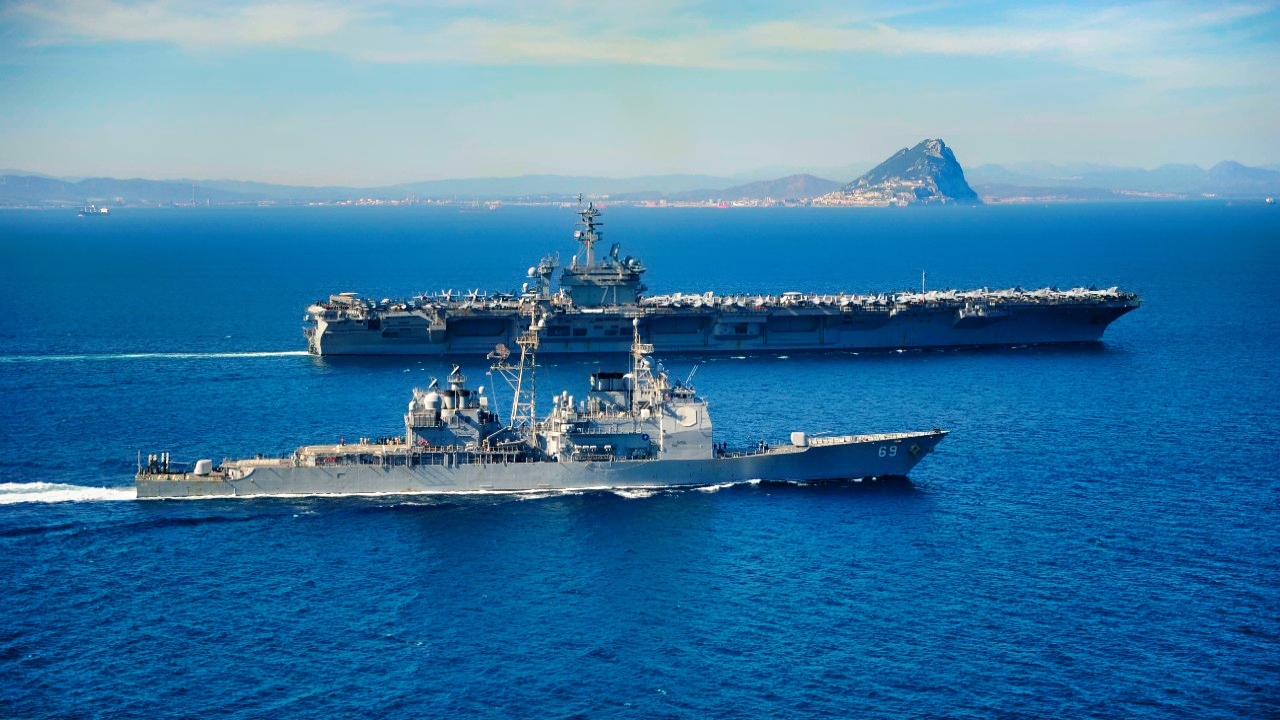Key Points – The U.S. Navy is rapidly retiring its Ticonderoga-class guided-missile cruisers, a move that is creating a dilemma between modernizing the fleet and maintaining current firepower.
-These powerful warships, equipped with the Aegis Combat System, are being phased out by 2027 to make way for new Arleigh Burke-class destroyers.
-However, some members of Congress are pushing to keep the cruisers in service longer to counter the growing Chinese navy.
-This debate is compounded by a scathing 2024 Government Accountability Office (GAO) report that found the Navy’s multi-billion dollar cruiser modernization program was a costly failure.
USS Ticonderoga-Class Cruisers: Being Retired Too Soon?
The Ticonderoga-class cruisers were initially planned as a class of destroyers. However, the increased combat capability offered by the Aegis Combat System and the passive phased array AN/SPY-1 radar, together with the ability to operate as a flagship, was used to justify the change of the classification from DDG (guided-missile destroyer) to CG (guided-missile cruiser) shortly before the keels were laid down for Ticonderoga and Yorktown.
The Navy built 27 of the multi-role cruisers that can fire a multitude of Tomahawk cruise missiles, RUM-139 ASROCs, and anti-ballistic missile munitions. The Ticonderoga class was designed to function as a member of a carrier strike group or amphibious-ready group and can perform interdiction and escort missions.
The US Navy’s Ticonderoga-class cruisers are being retired quickly, but this presents a sticky situation for the Navy.
Background of the Ticonderoga-class Cruisers
The US Navy states that guided missile cruisers primarily operate in a Battle Force role. These ships are multi-mission, capable of Air Warfare (AW), Undersea Warfare (USW), Naval Surface Fire Support (NSFS), and Surface Warfare (SUW) operations, serving as surface combatants that support carrier battle groups, amphibious forces, or operate independently as flagships of surface action groups.
Cruisers are equipped with Tomahawk cruise missiles, giving them additional long-range Strike Warfare (STRW) capability. Some Aegis Cruisers have been outfitted with a Ballistic Missile Defense (BMD) capability.
The lead ship of the class, USS Ticonderoga (CG-47), through CG-51, has been decommissioned. Over the next several years, 22 Ticonderoga-class guided-missile cruisers will undergo a structured modernization to ensure they reach their projected 35-year service life.
The Cruiser Modernization program aimed to enhance the CG-47 Ticonderoga class by modernizing the computing and display infrastructure, as well as the Hull, Mechanical, and Electrical (HM&E) systems.
Weapons and sensor sets will also be enhanced to improve their anti-submarine capabilities, including the addition of short-range electro-optical systems that can monitor the ship’s surroundings without emitting radar.
Additionally, routine machinery upgrades will be implemented to enhance all areas of the ship’s functionality. The modernized cruisers are expected to become more cost-efficient to operate as their service life is extended to serve in the fleet through 2030.
The Quandary of the Retirement of the Ticonderoga Class
The Navy plans to retire the entire Ticonderoga class by the end of the decade, or by 2027, to make room for the incoming Flight III Arleigh Burke-class destroyers.
However, some members of Congress are pushing to keep the cruisers in service for a more extended period, arguing that they bring firepower, radar, and significant capabilities to the Navy’s surface fleet. Of the 27 ships in the class, 14 are already retired (the oldest of the class).
It makes sense that the Navy wants to see the service make the modern Arleigh Burke cruisers as quickly as possible and incorporate them into the fleet. However, Congress is also right in that it wants the Navy to have as much firepower as possible at present.
Modernizing and maintaining these high-powered warships makes sense in a threat environment wherein China now operates a larger Navy than the US.
Quality matters as much, if not more, than quantity, yet the Ticonderoga-class cruisers bring substantial additional firepower, surface warfare capabilities, and anti-submarine capabilities to the fleet.
For these reasons, it might seem to make sense to revamp and essentially “keep” a number of the warships in service. However, this is the era of tight budgets, and there is only so much to allocate to all programs. This adds to the quandary.
The Navy has contracted for 10 DDG 51 Flight III Destroyers to arrive at an accelerated pace in the coming years.
Failures of the Cruiser Modernization Program
In December 2024, the US Government Accountability Office (GAO) published a scathing report stating that the Navy spent nearly $4 billion modernizing seven of its aging Ticonderogas over the past decade.
But only three of the large surface combatants will complete the modernization process, and none of those will gain an extra five years of service life as initially envisioned.
Nearly half of that money, $1.84 billion, was “wasted” on modernizing four cruisers that never returned to sea and were subsequently retired by the Navy. For that cost, the Navy could have built two new destroyers.
The GAO identified numerous issues with how the Navy conducted these modernization efforts, which serve as an example of how not to conduct an operation of this kind.
Hopefully, the Navy will learn from it.
About the Author:
Steve Balestrieri is a National Security Columnist. He served as a US Army Special Forces NCO and Warrant Officer. In addition to writing on defense, he covers the NFL for PatsFans.com and is a member of the Pro Football Writers of America (PFWA). His work was regularly featured in many military publications.
Iran War
30,000 Pound Bunker-Buster Bombs Might Not Be Able to Destroy Fordow











Pingback: The U.S. Navy's New DDG(X) Destroyer Is Circling the Drain - National Security Journal